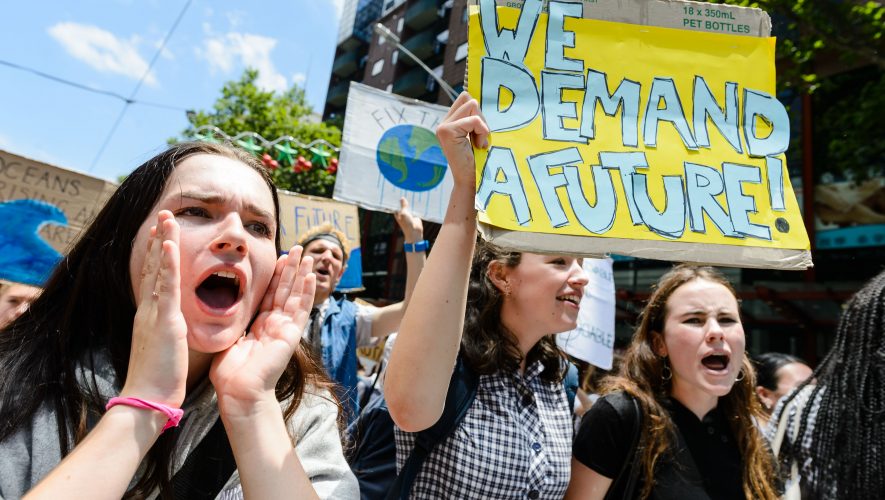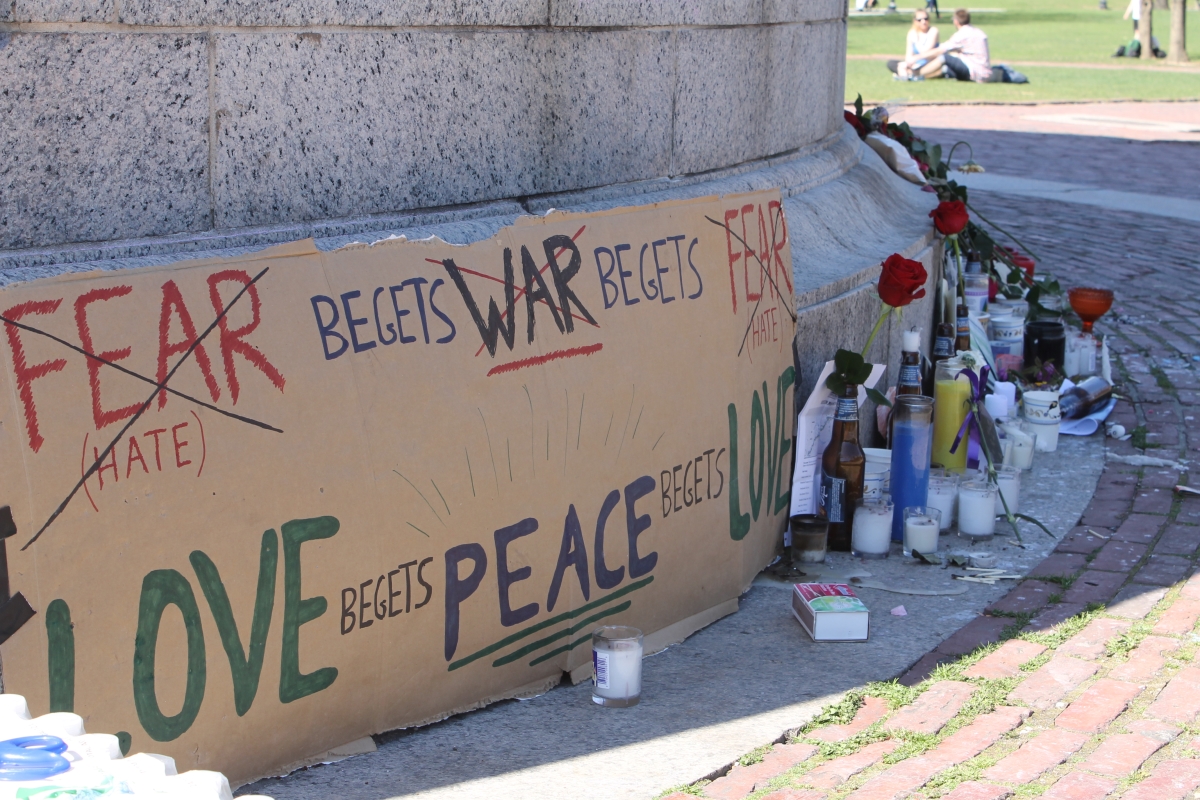Social media is revolutionizing how youth-led activism gains momentum. Young adults, once in the shadow of their parents, possess a powerful voice, constantly active through mobile technology. The power of that voice was evident around the world, when four million young people—many under the age of twenty-five—protested across 150 countries in September to demand urgent action on climate change in one of the largest youth-led strikes to date.
“It’s online activity and what happens in the real world. And clearly what we saw . . . was a historic moment,” explains Kevin Howley, a Professor of Media Studies at DePauw University and an expert in changing communication technologies.[1] “We’ve never seen a mobilization on that scale.”
Youth activism, like social media, is not new. Rachel Einwohner, a Professor of Sociology and Political Science at Purdue University, researches protest emergence and efficacy. She explains the role of youth activism in a broader historical context, suggesting that although the scale has changed today, youth protest is long-established.
“You think of many important movements in our country like the Civil Rights Movement. Youth, like college students and high school students, were hugely important in that movement and that was well before social media,” she notes.[2] “This is not so much about social media but it’s definitely about the youth.”
Howley explains how using various technologies to spread information and bring people together has historically been a pillar of civic engagement.
“Popular movements have always relied on technology and media communication to literally get the word out,” he says, referencing the printing press as essential to the success of the Protestant Reformation in 1517. The key to mobilizing young people is not the technology itself, but rather how groups use it. Using social media to rapidly and efficiently spread information has been instrumental in organizing large-scale protests.
While the climate strikes are the most recent success story of youth-led protest facilitated by social media, they are certainly not the only instance of vast turnout and successful political organization at the hands—or fingers—of young people.
March For Our Lives, a series of reactionary protests for gun control legislation in the wake of the 2018 Parkland high school shootings, is one of the most notable examples of successful youth activism prior to the climate strikes. These rallies, organized and led by students but attended by people of all ages, pushed for gun regulation and political accountability as the number of school shootings in the United States increases annually.
While official turnout numbers are debated, organizers of the demonstration estimate that approximately eight hundred thousand protesters attended the central March For Our Lives rally in the nation’s capital, making the student-led protest one of the largest in Washington to date. Researchers at Brandwatch attribute the success of the movement to a prominent social media presence; organizers used platforms like Twitter and Instagram—chiefly the hashtag #MarchForOurLives—to rally support.
Gen-Z cohorts will be disproportionately affected by problems such as gun violence and climate change—problems they inherited from older generations. This gives young people the authority and legitimacy to speak and act on these issues. The ability of social media to rapidly spread important information compounded with this legitimacy is a perfect confluence of events for organized protest.
However, there is a downside to social-media-driven organization. Fabio Rojas, a Professor of Sociology Indiana University and expert in organization and political sociology, focuses on how social media unites young people but hinders most from instituting tangible change within a larger political framework.
“One thing that’s different now than before is that these progressive movements are less leader-focused and some are anti-leader,” explains Rojas, giving the example of Occupy Wall Street and the movement’s relative lack of success.[3] He notes that this type of social-media-bred organization “goes against a lot of what social scientists have discovered about social movements: that . . . the real nitty-gritty organizing needs leadership.”
Sixteen-year-old Swedish climate activist Greta Thunberg helped mobilize the global climate strikes in 2018 when she started skipping school to demonstrate on the steps of parliament and inspired young people globally to do the same. While Thunberg is the face of the climate strike movement, she does not participate in grassroots organization to the same degree as protest leaders historically. Rather, Thunberg and other organizers within the climate movement have relied heavily on social media channels to organize—enabling the movement to grow exponentially and spread internationally. But with loose networks of organization, even with a figurehead, Rojas argues that similar coalitions have a hard time instituting tangible, policy-based change.
“These movements often make it hard to translate their particular goals into concrete actions,” notes Rojas, suggesting that partnering with well-established allies, like Black Lives Matter did with the NAACP, is often essential to success.
Young people have demonstrated the ability of social media to facilitate organized mobilization, but it’s hard to say whether student protesters—such as those in March For Our Lives and Occupy Wall Street––have accomplished tangible change in the form of legislation and globally implemented mandates.
March For Our Lives has been noted as an incredibly successful movement, putting pressure on legislators to pass stricter gun control laws and bringing gun control to the forefront of American political consciousness. But in reality, there have been no significant tangible changes in gun control laws since a string of shootings in 2018, Parkland included. Aside from federal gun reform blocks namely by Senate Majority Leader Mitch McConnell, state legislatures and district courts have fallen into a partisan standstill.
Occupy Wall Street sought to address income inequality, dominating corporate interest, and dark money expenditures associated with the rule of the one percent. While Occupy heightened the conversation surrounding economic disparity, political analysts consider it one of the biggest failures in organized protest. Without a leader or even a figurehead, protesters pushed for no tangible legislative appeals or policy mandates and, as expected, achieved none. Of the successes the movement attained, the most substantial has been energizing a base that supported Bernie Sanders in 2016.
When social movements spread so far geographically and ideologically, such as the climate strikes, key elements of traditional organization are lost in the framework. These elements must be retained to push for legislative orders and policy change.
While Rojas believes that efficacy in student movement is in part measured by tangible policy influence and change, Einwohner believes that a successful protest does not necessarily push directly for legislative change, but rather shifts public perception and powerful people indirectly. Einwohner describes forward momentum as the mark of a successful protest, nodding to the recent protests in Hong Kong.
“Those protesters kind of got what they wanted, but they’re so strongly mobilized that they’re about to push for more demands,” she explains. “So what was the success there and is any given success ever enough?”
Einwohner notes that the sheer scale of participation in the climate strikes indicates that these youth protesters could gain similar momentum.
“I wonder if the youth have more legitimacy to speak on this issue of climate change,” she suggests, as “they’re the ones facing the brunt of it and they’re also the ones who didn’t create it.”
Gina McCarthy, the former head of the Environmental Protection Agency under the Obama administration and an environmental health and air quality expert, voices a similar opinion. She highlights that simply getting legislators to listen is a success—and young people’s legitimacy on topics like climate change and school shootings can compel powerful people to listen.
“I think people really underestimate just how much action can happen if you mobilize people,” explains McCarthy.[4] “I know that if you want to call somebody on Capitol Hill and complain, if they get over twelve calls they start to panic. So if you have one hundred thousand people or twenty thousand people getting together, they’re going to sit up and take notice even if you’re not standing outside of their offices.”
McCarthy notes that, particularly in light of “the moral responsibility [older generations] haven’t actually lived up to,” young people “have a legitimacy to raise the issue with all of us.” She agreed that young people’s authority can “make us—the people who are in power and in government and in places of business authority . . . make change demanded of us.”
Einwohner similarly notes that if young people gain enough power and legitimacy to influence older generations less attuned to the topic of climate change, that may be the true mark of success.
“Maybe what’s more meaningful is not ‘did they get some demand met,’ but ‘do they have the kind of forward momentum to keep going and seek more goals, whatever those goals might be.’”
[1] Howley, Kevin. Interview by Taraneh Azar. Phone, September 23, 2019.
[2] Einwohner, Rachel. Interview by Taraneh Azar. Phone, September 24, 2019.
[3] Rojas, Fabio. Interview by Taraneh Azar. Phone, September 24, 2019.
[4] McCarthy, Gina. Interview by Taraneh Azar. Boston, October 23, 2019.



